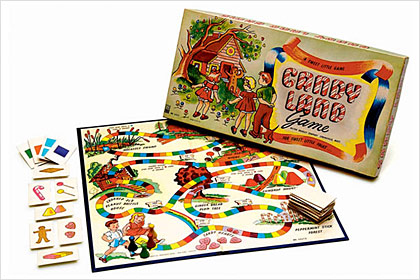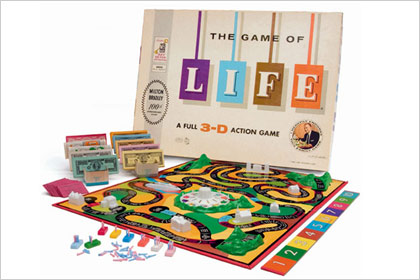AARP Hearing Center


Remember playing Clue or Operation as a kid? Or were you a fan of Mystery Date or Twister? Even with the rise of video games in the past few decades, these classics still remain popular today and help make up a $1 billion-a-year industry. "It’s hard to replace the face-to-face quality time you get with these games," says Tim Walsh, inventor of the game Blurt! and author of Timeless Toys. "They’re something you can do with the whole family — and they’re affordable."
Take a look at the fascinating history behind 10 of our favorite games — and watch the television commercials that helped them become bestsellers.
The Game of Life
Debut: 1860
Inventor: Milton Bradley
Company: Milton Bradley
Object of the game: In the original 1860 game, the goal was to reach a Happy Old Age by earning points for perseverance, honor and other admirable qualities. The goal for players of the redesigned 1960 version — which continues to this day — is to win the most money.
History: In 1860 Milton Bradley, who ran a Massachusetts lithography business, decided to use his idle presses to make games. As board games were still a diversion associated with gambling, Bradley focused on creating an instructional game of morals. He dubbed his invention The Checkered Game of Life and soon sold 40,000 copies.
Updated versions: The original game was updated several times between 1866 and 1911, but its popularity faded as games that promoted fun over morals swept the country. In the 1950s, the Milton Bradley Company hired game inventor Reuben Klamer, who worked with Bill Markham to update the game for the company's 100th anniversary. Klamer added a three-dimensional game board, tinkered with the rules, renamed it The Game of Life and inked a promotional deal with TV personality Art Linkletter. More changes came in the 1990s when the game added tiles that promoted environmentalism, family activities and community service. Now, 150 years after it was first created, fans can play it as a computer game or download it as an app.
Trivia: While the 1860 version penalized a player for gambling, the 1960 version offered winnings from gambling as a reward. Today's version doesn’t mention gambling.


Clue
Debut: 1948 (United Kingdom), 1949 (United States)
Inventor: Anthony Pratt
Companies: John Waddington Games Ltd., Waddington’s Games, Parker Brothers
Object of the game: Players try to discover who killed the host, with what instrument and in what room of his stately manor. With six suspects, six weapons and nine rooms, there are 324 possible combinations of the crime.
History: The game's creator, Anthony E. Pratt, was a patent clerk who served as a fire warden during World War II. In 1943, he wanted to make a simpler version of an old parlor game called Murder. Pratt and his wife, Elva, created a board game they eventually named Cluedo. After the couple perfected their idea, Pratt sold Cluedo to Waddington Games in 1947. In 1949 the game was sold to Parker Brothers for the U.S. market and renamed Clue. A 1985 movie version of Clue featured an all-star cast that included Tim Curry, Madeline Kahn, Martin Mull and Eileen Brennan.
Updated versions: Multiple versions of Clue were published in North America and the United Kingdom after 1949, but most of the changes were slight updates to the appearance of the characters and the mansion. In 2008, Hasbro released a modernized version called Clue: Discover the Secrets. This latest version of Clue is set at a dinner party at a swanky mansion hosted by a millionaire mogul. Just like in the original, it is the player's job to solve the murder, but there are new weapons, such as a barbell and a baseball bat, and a few new rules. Players can also try their hand at an Alfred Hitchcock edition, a Scooby Doo version, several computer editions and an app.
Trivia: In 1999 a bottle of poison was added to the list of possible murder weapons to celebrate Clue's 50th anniversary. The addition was made in honor of Pratt's prototype, which also originally included an ax, a bomb, a hypodermic needle and poison as potential weapons.


Candy Land
Debut: 1949
Inventor: Eleanor Abbott
Company: Milton Bradley
Object of the game: By matching colors to spaces, players follow a rainbow path through a candy-coated countryside — passing the Peppermint Stick Forest, the Gumdrop Mountains, and the Molasses Swamp — until they reach Home Sweet Home.
History: Retired schoolteacher Eleanor Abbott created Candy Land while she was a patient in a polio ward of a San Diego hospital in 1948. The children in the ward liked the game so much that Abbott decided to submit it to Milton Bradley. Executives at the company were excited by the game, but they never anticipated it would sell more than 40 million copies.
Updated versions: Since the 1950s the game's artwork, characters, and even its game pieces have been updated multiple times. Along with special editions, Hasbro, which took over Milton Bradley in 1984, offers an electronic handheld version and a computer game. For those who want even more Candy Land, there's an app for that.
Trivia: The first Candy Land games were sold for $1 and were advertised as a game to satisfy "the sweet tooth yearning of the younger set without the tummy ache aftereffects."





































































More From AARP
6 New Takes on Classic Board and Card Games
Just like some familiar favorites with a modern update11 Games That Deliver Fun for All Ages
Make holiday get-togethers merry with entertainment that reaches across generations
Why We Like Video Games (Maybe We're Control Freaks)
From phone puzzles to fantasy adventures, here's why digital gaming is devouring the world